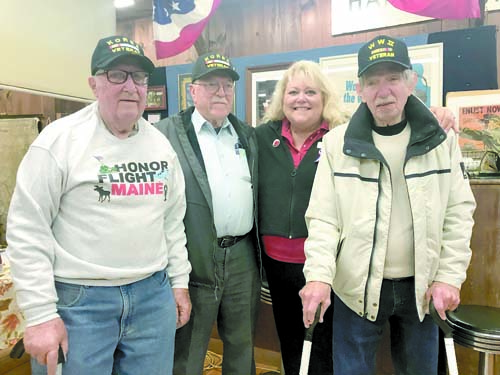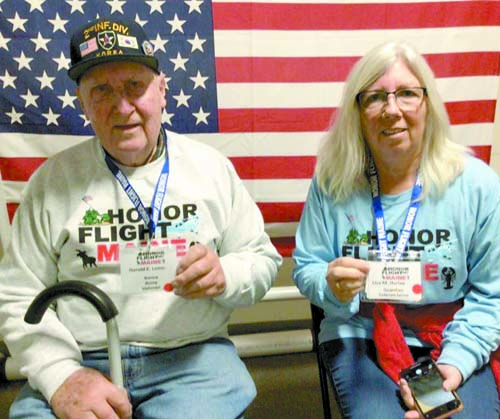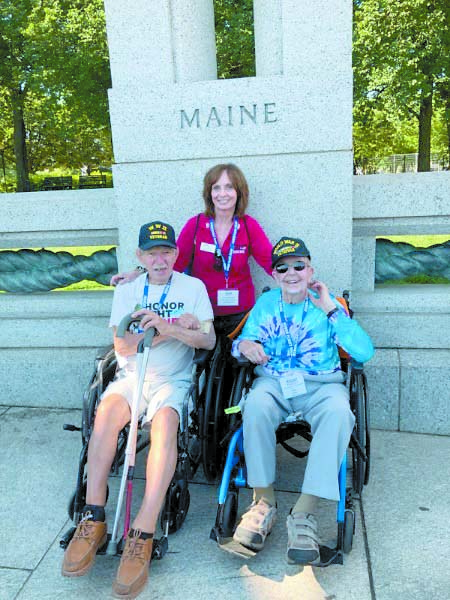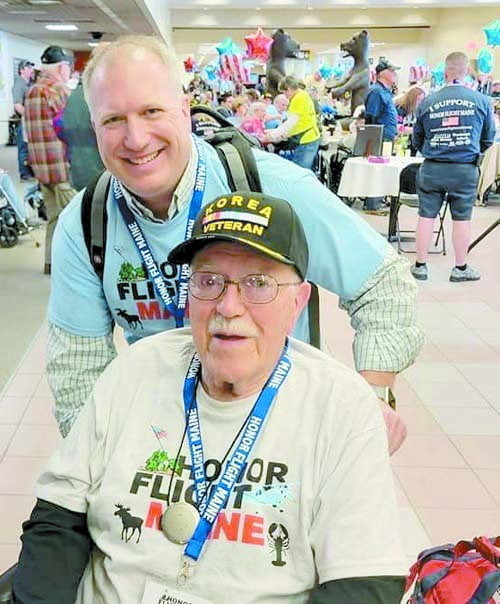‘Your service is revered’ — Honor Flight treats veterans like celebrities

By Dawn De Busk
Staff Writer
HARRISON— Most vacations are meant to be memorable.
An Honor Flight is designed to be incredibly memorable and to simultaneously make the veteran feel like the center of attention.
From the first stop at Fort McHenry to getting off the plane in Portland at the end of the journey, veterans on this trip are treated like celebrities, according to Laurie Sidelinger, an Honor Flight Maine board member and trip guardian.
“Coming home — many of you Veterans regardless of which war, WWII, Korean, and Vietnam especially. Many of you came home. You got off the bus, the train, you know. Maybe, you knocked on the door and had bean supper with your families and never said anything about your service. You just found jobs, went to work, and started families. You were just babies when some of you enlisted,” she said.
“We really do try to make it an experience where you feel like your service is revered the whole weekend. Especially when you come back because that welcome home you never got you do receive when you come back from an Honor Flight,” she said.
She mentioned one of the purposes of the trip was to make each and every Veteran feel like he or she is of the utmost importance.

That mission was accomplished, according to the area veterans who went. That is exactly how they felt: Special and important.
This year, a total of four Harrison residents took the Honor Flight. Hank Dumont, a Korean War veteran, was aboard the plane in late April 2022. Just three weeks ago, in October, Milton McKeen, Jr., Harold Leino and Ray LaFrance took the trip. Several years earlier — in 2018, Phillip Dennison was treated to an Honor Flight. Sidelinger accompanied these local residents.
On Sunday, Sidelinger was the guest speaker at the Harrison Historical Society Museum. She talked about Honor Flight Maine and told stories about the experiences, especially being at the Tomb of the Unknown Soldier.
The Honor Flight itinerary builds the entire three-day trip around front-row reserved seating at the Tomb of the Unknown Soldier during the changing of the guard.
“So, our veterans come into Arlington and we go slowly through all of the roads that lead to the amphitheater. Our veterans had front row seating to watch the changing of the guard. At times, they had Wreaths Across America, and someone in our group place the wreath on the Tomb of the Unknown Soldier,” she said.
“There was front row seating to the plaza where the sentinels go back and forth. The sentinels are very friendly. We are able to ring the bell and bring them gifts down below where they live and study,” she said.
“One thing we always mention to our veterans is that when they are sitting there, and when the sentinel goes by and drags their feet. It is not because they are tired. It is not because there is something wrong with their shoes. You can hear the metal. That is their acknowledgement and their ultimate showing of respect to the veterans sitting there. You can literally hear the scraping on the granite as they go by,” Sidelinger said.
Several of the veterans agreed the Tomb of the Unknown Soldier topped their list as an emotional experience.
World War II Veteran Ray LaFrance was given an important role at the memorial.

“I actually was able to put a wreath at the Tomb of the Unknown Solider. We took eight minutes of video. It was emotional,” LaFrance said.
He could not settle on just one favorite monument or moment in time.
“I would say Iwo Jima, and also the unknown soldierand the second World War monument. All the military monuments: the Navy, the Army, the Marine Corp, the nurses — they were all very impressive. It was breathtaking. The reception at the airport when we came back to Maine,” he said.
“We are representing Maine. We are representing the soldiers who couldn’t come,” LaFrance said.
Another resident was also moved by the ceremony at the unknown soldier’s tomb.
“I like the changing of the guard at the Tomb of the Unknown Soldier. There are several from Korea — they never found them. There was 8,000,” said Harold Leino, who served in the U.S. Army during the Korean War.
In fact, Leino was on foreign soil when that war came to an end on July 27, 1953.
“I was there when the war ended. I always remember the Chinese coming out their holes and waving at us the next morning. Because it was 10 o’clock at night when the war ended,” he said.
Korean War is called the Forgotten war, he said. While in Arlington, he visited the Korean War memorial.
“There are 77,000 names on the granite stones around the Korean War Monument. I saw the names of three of my buddies. When I found those names on those monuments, it was really a tearjerker,” Leino said.

“Getting there for the first one [stop]. They took us to Fort McHenry [in Baltimore]. That is where the Star-Spangled Banner was written. That was really a highlight. They sang it there. That was a tearjerker,” he said.
“Arlington Cemetery — it was beautiful. It was a highlight,” he said.
“I enjoyed every minute of it. Anyone who is thinking about going, they should sign up for it,” Leino said.
Korean War veteran Henry “Hank” Dumont was impressed with the high level of safety and organizational skills of the people with Honor Flight Maine.
He was really pleased with the procession, the two buses escorted by motorcycles, traveling from place to place.
“When we went from one city to another, we went about 15 miles with 35 motorcycles in front of you. They don’t stop at any lights. You look at all these guys on motorcycles leading the two buses,” he said.
He was blown away by the Korean War memorial at Arlington Cemetery.
“That was a surprise. They have it just like it was over there. You walk in and see the statues of the soldiers dressed in same uniform as I was, soldiers in droves, with grass between them, not cut, not trimmed, long rough stuff just like it was over there,” LaFrance said.

